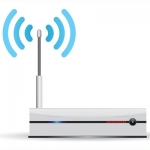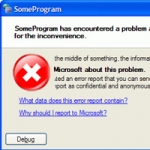It's the start of the 2011 hurricane season, and with Hurricane Irene making contact with Atlantic coastlines this week, it certainly doesn't hurt to make sure your business is prepared for a disaster. Even if you are lucky enough to not be affected by these devastating storms, there are plenty of opportunities for nature to cause havoc on our way of life. It's never to late to put together a Disaster Recovery Plan (alternatively known as a Business Continuity Plan) in case a natural (or otherwise) disaster were to occur for you. Nobody wants to think a disaster might happen, but it isn't impossible. Here are a few steps small businesses can take to become better prepared.
Directive Blogs
Have you ever noticed that the vents around your computer seem to pick up a lot of thick dust? Computers and Laptops house internal fans that keep the inside components from overheating, which essentially makes them mini-vacuums that constantly suck air and dust in. Dust can act as an insulating blanket and prevent your hardware from cooling, causing damage over time and wearing down your computer faster. Hit the jump for some more information and some ways to help keep your computer clean so it can live a long healthy life.
I'm sure nobody has missed out on any of the storms happening here in New York. Even our lights have been flickering. Mother nature can be cruel to your IT; a well-placed bolt of lightning can do plenty of damage. Of course, we always recommend quality UPS systems to our clients to protect their most valuable tech, and good surge protectors for everything else (not power strips, mind you, they aren't the same). Regardless, whether there's a risk of the power going out or not, it's important to save often and keep your files backed up. Here's a few tips after the jump.
Veterans to building and running small and medium-sized businesses probably know about the huge initial start-up costs. A small business needs to consider investing in all of the necessary infrastructure, from things like desks, chairs, computer equipment, security devices, break room appliances, heat, air conditioning, a website, marketing materials… the list goes on. Today, small businesses are finding new ways to streamline and reduce the costs of getting started. Hit the jump to see a few ways small businesses are cutting high start-up costs.
Wi-Fi can drastically increase your mobility around the home and office, and over the past few years wireless technology has become faster and incredibly reliable. Unfortunately, the signal only goes so far, and can be obstructed by walls, metalwork, and other features throughout the building. If you want to boost your signal, you can try out some of these tips.
Let’s take a break from all of this technical mumbo-jumbo and talk about something that is much more important: health. You could have an arsenal of the world’s coolest gadgets and technology in front of you, but if you aren’t practicing good health habits, they won’t do you a lot of good for very long. Normally when we think of injuries, we think of doing something that pushes our body’s limits. Injuries can occur just from practicing poor habits during those 8-hour daily work marathons many of us run each day. I’ll go over a few simple ways you can optimize the ergonomics of your work environment to improve comfort and prevent physical stress associated with bad habits often found in the workplace.
If you haven't heard of Dropbox, you are in for a real treat, especially if you like making it extremely easy to access certain files. Dropbox is a service that provides secure file hosting and synchronization between multiple computers and devices so you can quickly access the data you need most no matter where you are, and when you get back to your main workstation, the updated version of the file will be there waiting. Did I mention Dropbox has a free version? Hit the jump to learn why we love this service.
If you don't have an Exchange Server, it's likely that your email isn't being backed up. Fortunately, with Microsoft Outlook, it's not very difficult to create a copy of your email, contacts, calendar, and other Outlook data. While this isn't a complete backup solution, you can at least take the current state of your Outlook data and store it elsewhere for safe keeping in the event of data loss or a hardware malfunction that causes you to lose your precious data.
USB thumb drives are fantastic. Small, portable, fast, and highly compatible; these devices make it easy to transfer files and documents from one place to another. If you are burning the midnight oil working on a presentation or document from home, a thumb drive is a fast, cheap solution for grabbing those files and taking them from one device to another. Of course, there are plenty of other alternate ways to move files that are even easier and even more fool proof (how many of you have lost a thumb drive or let one go through the wash?), so the thumb drive has been becoming less popular for businesses. If you hate to see perfectly good technology go to waste, check out these 3 tricks that give new life to your old thumb drive.
Sometimes the best things in life are free, and software is no exception (who doesn't love FREE?). Surprisingly, free applications can rival the more expensive commercial apps that offer similar features. We aren't necessarily saying these apps are ready for businesses to use, but for a home user who doesn't want to purchase expensive commercial software, free is the way to go.
Don't you hate it when you contact us for tech support with a strange issue, and then you can't recreate it? Don't feel bad. It happens all the time, even to us. Sometimes those rarely occurring issues can't be fixed unless you get some photographic evidence of what's going on. This quick guide will show you how to take screenshots of your desktop.
With all the fancy content management systems out there making it easy for users to manage and update their website, suddenly creating new content and pages on your site becomes a snap, and anyone can do it. While CMS's like Joomla empower those outside the professional web design field to completely turn their website into a living, breathing dynamic canvas, there are still a few simple best practices that one might not know without a little experience. One of the big ones that often get missed are images. In this article, we'll show you how to work with images for the web so you get the best results possible when putting pictures on your website. This will apply to blogs, social media, and just about any other method of publishing on the web.












